Division of Bacterial Diseases (DBD) News Bulletin
This website is archived for historical purposes and is no longer being maintained or updated.
April 16, 2013: Content on this page kept for historical reasons.
In This Issue
- Best Wishes
- Quarter 1
- Quarter 2
- Quarter 3
- Quarter 4
- 2013 Events
Winter 2012
Quarter 2
Pertussis – a Never-Ending Story?
Chinese immigrants in Washington (WA) state call pertussis the “100-day cough.” Other ethnic groups in the state, the first in the nation to declare a pertussis epidemic in 2012, have no words in their own language to describe pertussis, or whooping cough.
Pertussis is a highly contagious bacterial disease that affects all ages, but is most dangerous for infants. To prevent pertussis, 5 doses of DTaP vaccine are given to children and Tdap is recommended for everyone 11 years or older, especially pregnant women and those in close contact with infants.

EIS Officer Sarah Meyer (left) and Julia Chang (right), a CDC experience fellow, reviewed medical records at a Seattle, WA, hospital.
The United States has had record-high numbers of reported cases of pertussis this year, with over 36,000 cases and 16 deaths reported through late November. In April 2012, in WA—where there is a widely diverse ethnic population often isolated by language, customs and location—the state’s Secretary of Health declared a pertussis epidemic. By June 16, there were 2,520 cases reported (37.5 cases per 100,000 residents) in WA, a 1,300% increase compared with the same period in 2011. This is the highest number of pertussis cases reported in WA since 1942. Compared with the incidence in WA, the national incidence for the same period in 2012 was lower overall (4.2 cases per 100,000 population).
In response to this ongoing epidemic, the WA State Department of Health established an incident command structure to coordinate epidemic response and surveillance activities and reached out to CDC for technical support. CDC mobilized very quickly and DBD responded by providing personalized outreach to media, consumers and providers, as well as epidemiologic and laboratory support and leadership on guidelines and policy. Our involvement is on-going.
During the height of the declared epidemic, DBD assisted WA by checking the accuracy of the lab testing performed in local hospitals and laboratories. To further confirm Bordetella pertussis as the etiology and evaluate the contribution of other Bordetella species, multi-target PCR assays were performed on a subset of specimens submitted to CDC by WA Public Health Laboratories and a commercial laboratory.
Last spring, CDC collaborated with the WA State Department of Health on a series of media roundtables about the pertussis epidemic, health risks, and the importance of vaccinating children and adults. Media outlets serving WA Native American, Asian American, Chinese, Japanese, Korean, Vietnamese, Filipino, Hispanic and African immigrant communities participated in the media roundtables that were designed to drive home to ethnic communities the critical importance of getting vaccinated.
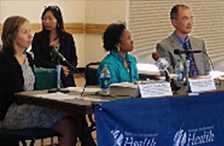
Stacey Martin (left) took part in the media roundtable to help educate WA’s very diverse media about the devastation of pertussis so that they could inform their audiences—in their own languages—of how important it is to protect babies and young children—really everyone in the family—through vaccination. She helped to put a human face on the pertussis epidemic.
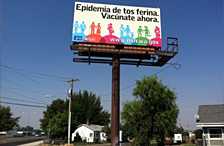
Spanish-language billboard about pertussis in Washington state
Information about pertussis was translated into multiple languages and made available on the Internet. Roadside billboards still dot the WA skyline and colorful poster ads on mass transit remain in place. Our healthcare provider education is focusing on clinical presentation, appropriate diagnostic testing, and treatment and prevention recommendations with specific emphasis on vaccination to prevent transmission.
Nationally, and in WA, pertussis is being reported in teenagers. DBD took advantage of the opportunity to learn how well and for how long Tdap vaccines protect teenagers against pertussis by collaborating with the health department on a large-scale evaluation conducted by rotating teams of epidemiologists who looked at the state’s vaccine database and made visits to doctors’ offices to review vaccine histories of teenagers with and without pertussis.
By the end of September, 4,190 cases of pertussis had been reported in WA, almost 10 times more than the same time period in 2011 when 427 cases were reported. Given the number of cases, it is fortunate that there have been no reported fatalities.
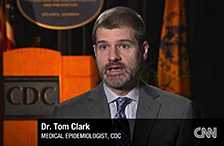
Tom Clark appeared on CNN and WebMD to discuss the WA outbreak and, in his editorial commentary published in the journal Pediatrics in August, Tom noted, “92 to 95% of the population must be protected in order to halt transmission of pertussis. While childhood diphtheria, tetanus toxoid and acellular pertussis vaccine (DTaP) coverage is 95%, the vaccines currently in use are approximately 85% effective overall; the evidence is increasing that immunity may wane more rapidly than anticipated.”
The ongoing pertussis epidemic in WA reflects the evolving epidemiology of pertussis in the United States. The collaboration between the agency’s staff in DBD and WA is a success story for what can be accomplished working at the state and local level to address disease outbreaks. The focus of prevention and control efforts has to be the protection of infants and others at greatest risk for severe disease and improving vaccination coverage in adolescents and adults, especially those who are pregnant. Pertussis vaccination remains the single most effective strategy for prevention of infection.
DBD continues to keep the Advisory Committee on Immunization Practices (ACIP) informed of our findings on outbreaks and surveillance activities in WA. ACIP will consider this information to carefully help guide discussions on how best to use vaccines to control pertussis, and whether additional vaccine doses might be needed.
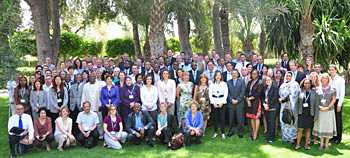
Amanda Cohn, Rana Hajjeh, and Chris Van Beneden participated in the WHO annual NUVI meeting (New and Underutilized Vaccines) meeting in Marrakech, Morocco. Chris presented the talk “Measuring the impact of Streptococcus pneumoniae and Haemophilus influenzae type b conjugate vaccination: An introduction to WHO’s Vaccine Impact Manual” and Rana was part of an expert panel that discussed vaccine introduction in low middle income countries.
Rana Hajjeh attended the Nigerian National Vaccine Summit in Abuja, Nigeria. The high-level meeting of national and international delegates, including the First Lady of the Federal Republic of Nigeria, was organized to join forces with the international community to expand vaccine access nationwide with the goal of achieving universal vaccine coverage for all Nigerian children by the year 2015. Over one million Nigerian children under age 5 die annually from vaccine-preventable diseases.
The Epidemic Intelligence Service (EIS) hosted its 2012 annual scientific conference for the national and international public health community in Atlanta. Completing the two-year post-graduate training program of service and on-the-job learning in the practice of applied epidemiology are Alicia Demirjian, a graduate of the American University of Beirut, and Aaron Harris, a graduate of Tufts University, in the RDB while Hajime Kamiya, a graduate of the Mie University School of Medicine, and Stephen Ko, a graduate of the Medical College of Georgia, are stationed in the MVPDB.
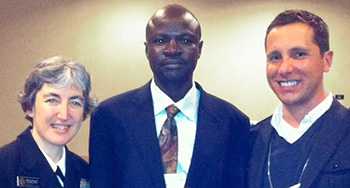
NCIRD Director Anne Schuchat and MVPDB’s Ryan Novak are pictured with Tiga Felix Tarbangdo, a surveillance epidemiologist with the Burkina Faso Ministry of Health, whose visit to the United States was funded by the International Conference on Emerging Infectious Diseases ICIED Leaders program as part of the group’s 8th meeting in Atlanta in April. Mr. Tarbangdo met with MVPDB staff working on meningitis and attended an Intermediate Epi Info training program along with MVPDB’s Amanda Faulkner, Sema Mandal and Jessica MacNeil.

DBD staff Pam Cassiday, Amanda Faulkner, Cindy Hatcher, Lauri Hicks, Stacey Martin, Alison Patti, Tami Skoff, Emily Weston and Jonathan Wortham helped to raise funds for Children’s Healthcare of Atlanta in The Color Run.

Emily Weston (on right), ABCs, along with Melony Fortuin-de Smidt from The Group for Enteric, Respiratory and Meningeal Diseases Surveillance (GERMS SA) in South Africa at the 2012 ABCs Surveillance Officers’ Meeting where Melony presented on Haemophilus influenzae in South Africa.
Stacey Martin (DBD/MVPDB) was the speaker for “Coughing up the Facts on Pertussis—Emerging Trends and Vaccine Recommendations,” a Current Issues in Immunization NetConference.
NCIRD and many partners joined ABC News’ senior health and medical editor Dr. Rich Besser for a live Twitter chat for World Meningitis Day, which had more than 4.5 million impressions. Amanda Cohn and Jessica MacNeil answered questions about meningitis and meningococcal vaccines.

Claressa Lucas was featured in a CDC Connects story after she used her beekeeper skills to help remove a swarm of honey bees from CDC Health Rider Donnie Powell’s Harley-Davidson bike in the Building 16 parking deck one afternoon last spring.
The National Center for Public Health Laboratory Leadership of the Association of Public Health Laboratories (APHL) selected MVPDB’s Jarad Schiffer to join the fifth Cohort of the Emerging Leaders Program. Jarad will participate for a year in team building, skill development and interactive social and professional networking to address the current issues and problems characteristic of the current laboratory environment.
PCV13 Licensed for Adults
and Recommended for Immunocompromised Adults
FDA licensed PCV13 for adults age 50 years and older in December 2011. At its June meeting, ACIP voted to recommend that adults 19 years of age or older with immunocompromising conditions, functional or anatomic asplenia, CSF leaks or cochlear implants, and who have not previously received PCV13 or PPSV23 receive a single dose of PCV13 followed by a dose of PPSV23 at least 8 weeks later.
Chris Van Beneden provided expert guidance for an interview with TeleMundo on necrotizing fasciitis.
- Page last reviewed: April 16, 2013 (archived document)
- Content source:


 ShareCompartir
ShareCompartir